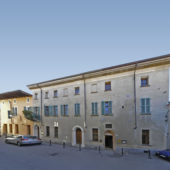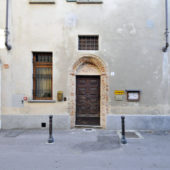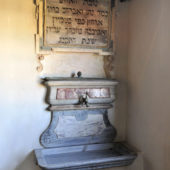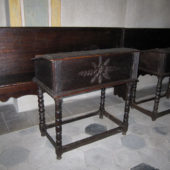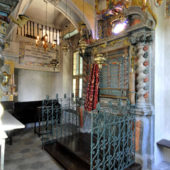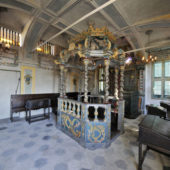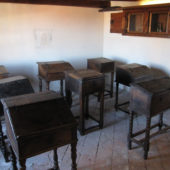The plain exterior hides an ornate Baroque interior.
Cherasco Synagogue is one of the sixteen synagogues still in existence in the Piedmont area in Italy. It is an Orthodox synagogue. Most of its congregants have been Sephardic; however, most of its history remains a mystery.
A community of Jews involved in banking and silk production is recorded as having been present in what was then the small town of Cherasco, since the 16th century. The date the Cherasco Synagogue was built is unknown; however, there is a stone plaque above a stone basin which was used for ritual washing on a staircase, dated 5557 (1797) and this most likely either refers to the date of construction or renovation.
The small building has a plain façade, so that it would blend in with the buildings around it, as a precautionary measure against persecution. This was common of synagogues built in the same era. They didn’t want news of their worship to reach Christian ears, thus provoking either anti-Jewish measures such as being forced to live and/or worship inside a ghetto. Inside the building is an unusual lovely, hand-painted baroque sanctuary. It is quite small and largely lit by windows facing onto a courtyard, as well as by a few brass chandeliers gracefully lifting their arms upward. The walls and barrel-vaulted ceiling are a grey-blue with peach accents, stenciled floral designs, and scriptures in Hebrew. Paned, shuttered windows line the walls.
The 18th century late baroque ark and bimah feature tortile Solomic (spiral) columns with Scamozzi capitals, which are quite typical of Italian synagogues. The ark is situated on the East wall, so that the congregation faces Jerusalem. This layout is common in synagogues. The ark is carved in wood and painted in grey-blue, flanked on each side by tortile Solomic columns with Scamozzi capitals. The Ten Commandments are gilded on the doors of the ark. The ark sits on a platform up a few steps and there is a hand-wrought blue-grey iron gate at the sides of the platform attached to the ark. Above the ark is a round stained glass window. Uncommon among Italian synagogues, the bimah in Cherasco is not on the opposite wall of the synagogue, but is situated in the center of the sanctuary. It is also exquisitely carved of wood and painted of grey-blue, with blue, wine and peach accents. The bimah not only features eight columns with beautifully painted Scamozzi capitals, it also boasts two entranceways and an exquisitely painted and gilded baldachin. The women’s gallery is upstairs, at the back of the sanctuary, separated from the main sanctuary by railing. Simple, very dark wood furniture and pews, which line the walls, sit upon hexagonal Italian tiles of grey and cornflower blue, providing a striking contrast. There is also an additional room that was once used as the schoolroom for the community.
The Synagogue has been preserved, but sadly no longer serves a congregation. Since 2003, the schoolroom has been used to exhibit “Jewish Life and Culture – Photographic Documentation of the Jewish Presence in the 18th and 19th Centuries,” curated by Girogio Avigdor in 1984. The Foundazione Debendetti Cherasco 1547 is actively working to promote the city of Cherasco, to raise funds to maintain the synagogue, the protection, promotion and development of artistic and historical heritage, in particular the past presence of the Jews in the city of Cherasco; to promote Jewish and French culture and art; and to promote scientific research of special social interest. The foundation also arranges tours of the synagogue.
Although much of Cherasco Synagogue remains a mystery, it is significant that the city’s present inhabitants are eager to keep the Synagogue, Jewish culture and traditions alive in Cherasco

